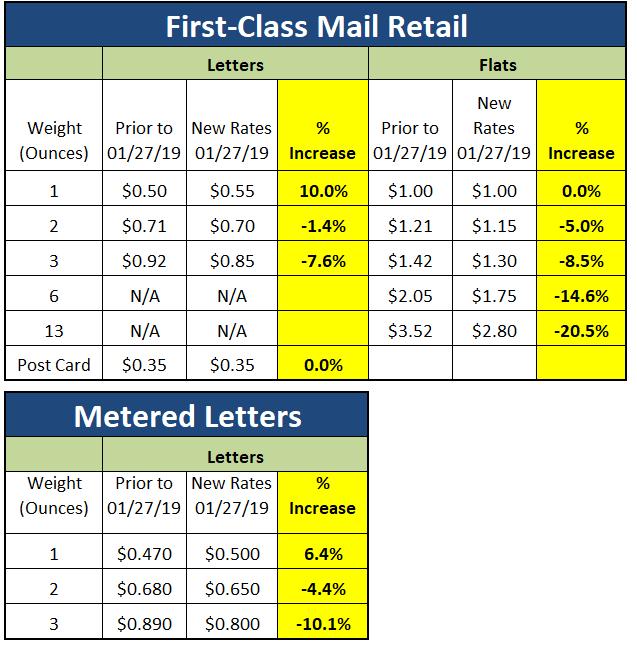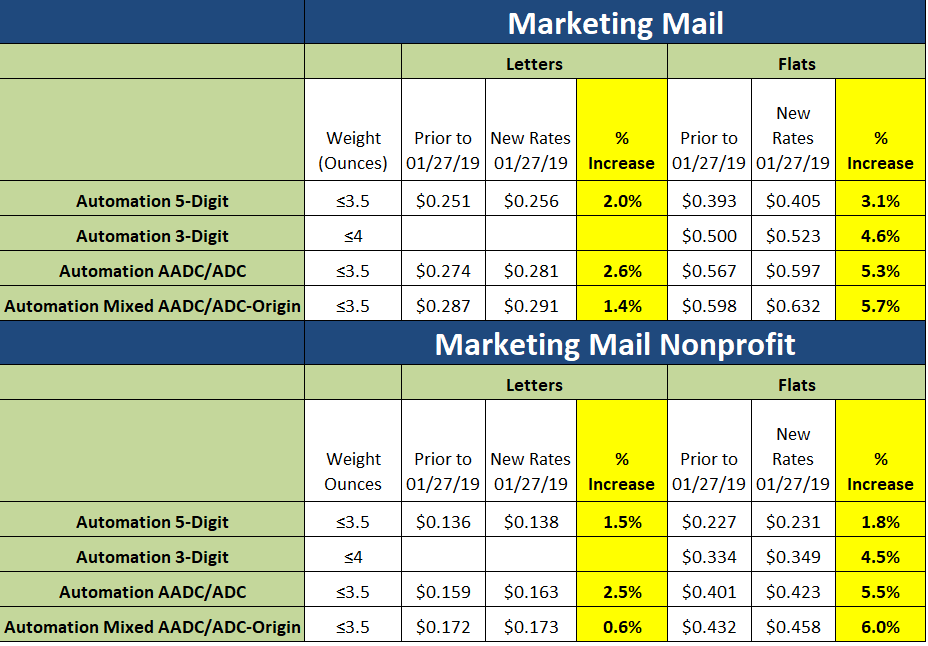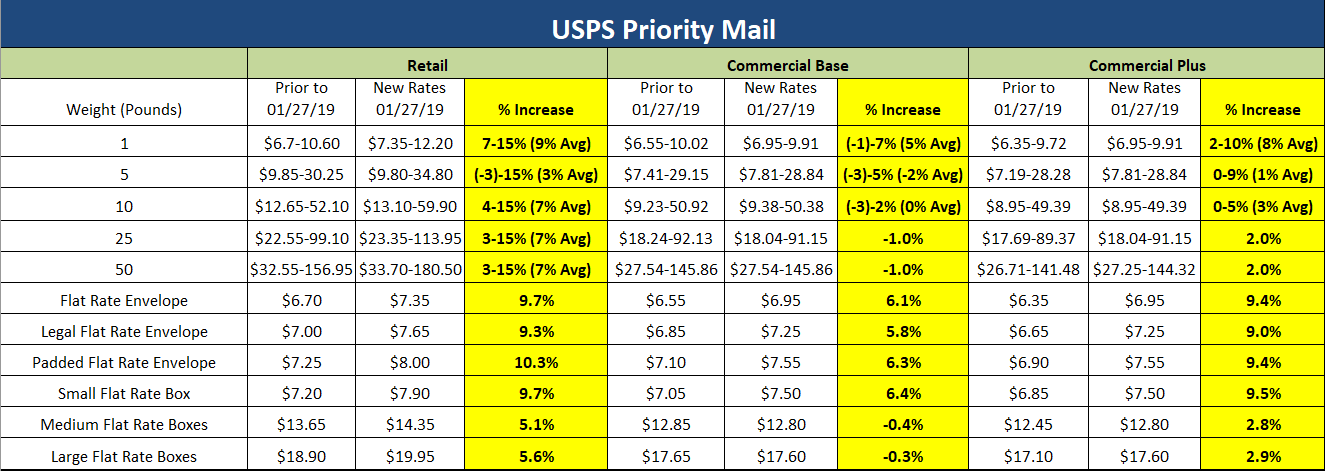When the USPS talks about an average 2.5% increase, it’s important to remember that this is overall. Based on the type of mail you send, the increase could be higher or lower. You need to look at the class, weight, zone, density, and special services required to see the true impact. Let’s take a look at the main classes of mail to identify the specific increases and decreases. This will hopefully help you budget by seeing the impact of the most common services that you use today.
First-Class Mail Single Piece: 20% Decrease to 10% Increase

The price of a stamp is going from $0.50 to $0.55, which is a 10% increase! This is compared to metered letters, which is increasing from $.47 to $.50 (6.4% increase). This is still the most significant savings ever offered in the US mailing industry because it means that by using a postage meter or PC postage, you will now save $0.05 per piece, or 10%. Discounts are often tied to doing more work, such as barcoding or sorting, but this is an automatic savings for just using a system to print postage (and the system can cost as little as $15 per month). The USPS reduced the additional ounce rate from $.21 to $.15, so the price goes down significantly as items get larger. Regardless of if you use retail or metered mail, you should budget for a significant increase in this category because the majority of mail clients process is one ounce.
Flats will see the one-ounce rate stay the same at $1.00, but with the reduction in the additional ounce rate, as the items get heavier, the rate goes down significantly.
First-Class Mail Commercial: 0 to 3.1% Increase

The commercial rates saw minimal to no increases with this rate change. Automation letter rates are going up at about one percent, with the highest sort levels seeing the greatest impact. Flats are increasing at two to three percent. Postcard rates are staying flat. It is interesting that the presorted (non-automation rates) are staying basically the same, while the automation classes are seeing increases. This is counter to the typical increase where the USPS provides additional workshare discounts for mailers pushing for automation.

The biggest change in this category occurred a few years ago when the USPS increased the weight limit for the commercial letter rates to 3.5 ounces. The goal was to increase the value of the mail piece, allowing customers to add additional content at the same price.
When you look at the chart above and compare the rates of a three-ounce metered letter at $0.80 to a commercial rate at $0.383, this is a 52% savings! This is a big win for presort services that are now more valuable because of the savings they can provide. Meanwhile, for flats (9x12 or 10x13), consider folding those into 6x9 envelopes. The savings can be significant with these new rates and weight savings. A three-ounce flat at $1.30 now could cost as little as $0.383 assuming it could be automated through in-house software or presort services.
Marketing Mail (Formerly called Standard Mail): .6% to 6% Increase

Marketing Mail letter rates are increasing at approximately two percent while flats are increasing anywhere from two percent to six percent. Nonprofit rates seem to be increasing at similar percentages as well. If you were taking advantage of destination entry discounts, the letter rate savings is decreasing by nine percent, whereas flats it is increasing by up to five percent as you can see from the table below.

Priority Mail: 3% Decrease to 10% Increase (Depending on Weight and Zone)

Priority Mail is the most popular package service for the USPS and covers items weighing 13 ounces to 70 pounds, and it is delivered in one to three days throughout the US. The rates are based on the weight and zones, which are determined by the distance you are shipping the item. They also have three different rate categories based on the type of customer:
· Retail – Rates that you get at the counter at the Post Office or through a postage meter.
· Commercial Base – Customers that use an approved PC Postage solution get significant discounts over retail rates as an incentive to streamline the way packages are labeled, barcoded, and data is transmitted.
· Commercial Plus – Customers that ship over 50,000 items per year can get additional discounts with an agreement with the USPS.
Highlights
· Retail rates are seeing the largest increases, with an average of seven percent
· Commercial rates are seeing the lowest increase with up to one percent increases and flat-rate items are increasing around four percent.
· Commercial Plus rates are now the same as Commercial Base rates with no additional incentive from a rate structure perspective.
· If you are running your Priority Mail items at retail rates using Click-N-Ship or a postage meter, consider switching to a PC Postage solution that utilizes commercial rates. This would save you 18% overall and ranges from five to 40% based on weight and zone.
Priority Mail Express: 3% to 10% Increase (Depending on Weight and Zone)

Priority Mail Express rates have increased slightly across all categories. Here are the highlights:
· Retail rates increased eight percent overall but only six percent for Flat-Rate and items that weigh less than 10 pounds.
· Commercial rates increased six percent overall but five percent for Flat-Rate and items that weigh less than 10 pounds.
· Commercial Plus discounts have been eliminated and rates are the same as Commercial Base.
First-Class Mail Package Service: 1% to 28% Increase

In the less-than-one-pound market, the USPS has a complete monopoly, and you can see that they are rethinking why they are providing some of the discounts in this segment. The private carrier rates all start at one pound, while the USPS goes to the ounce. Think about the companies sending light parts, for example; these packages can be sent for around three dollars with the USPS while the private carriers could charge double or triple that amount. We are seeing the largest increases in this segment, with retail rates going up 10-22% and commercial rates increasing seven to 19%. The biggest change is they have moved from flat rates to zone-based rates. This means items will get more expensive the farther away they are being sent, which will drastically affect mailers who send across country.
Additional Rate Change Items



Conclusion
To budget for this increase, you need to look at the type of items you are sending, and the weight and zones that are most common, to truly estimate the impact.
Adam Lewenberg, CMDSS, MDC, President of Postal Advocate Inc., runs the largest mail audit and recovery firm in the United States and Canada. They manage the biggest mail equipment fleet in the world and their mission is to help organizations with multi-locations reduce mail related expenses, recover lost postage funds, and simplify visibility and oversight. Since 2013, they have helped their clients save an average of 60% and over $45 million on equipment, avoidable fees, and lost postage. He can be reached at 617.372.6853 or adam.lewenberg@postaladvocate.com
Click here to return to the USPS rules and regulations topic page.













